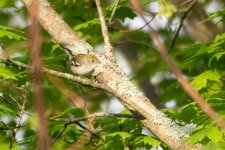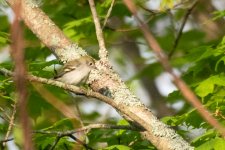-
Welcome to BirdForum, the internet's largest birding community with thousands of members from all over the world. The forums are dedicated to wild birds, birding, binoculars and equipment and all that goes with it.
Please register for an account to take part in the discussions in the forum, post your pictures in the gallery and more.
You are using an out of date browser. It may not display this or other websites correctly.
You should upgrade or use an alternative browser.
You should upgrade or use an alternative browser.
Warbler? Worcester County, Massachusetts (1 Viewer)
- Thread starter Misenus
- Start date
More options
Who Replied?Misenus
Well-known member
Thanks, I think you're right. And there were other chestnut-sided around when I took this.Looks like a dull chestnut-sided warbler.
AveryBartels
Well-known member
As mentioned by others, Chestnut-sided. In this case a female.
Or is 1st-winter male also as dull as this? - and this bird does seem to have a tiny touch of visible chestnut on the flank.a female

If I read the Pyle guide correctly, this problem disappears around March when the 1st winter male moults into something a lot closer to the adult male summer plumage.Or is 1st-winter male also as dull as this? - and this bird does seem to have a tiny touch of visible chestnut on the flank.
Niels
...and 1-st winter female doesn't?! 🤔...March when the 1st winter male moults into...

It seems both sexes moult during that period. The point of my post was that a male born last summer would be more like an adult male now and therefore should not be a cause of confusion when the bird is female like....and 1-st winter female doesn't?! 🤔
Niels
But that's the point... Breeding-plumage male and female are actually pretty similar to each other, ie multicoloured. So you could only sex this bird by the amount of chestnut on its flanks - the fact that it's mainly green is irrelevant. I guess. (And it's moulting 2 months late. Ish.)

According to Pyle: the adult males have rather extensive chestnut on underside even in fall/winter. However, if this is a bird that is moulting a lot later than what he describes, then I agree that all bets are off with regards to sex, because then it could be a bird from last summer and those are not safely sexed.
Niels
Niels
Indeed, yes - that was my point...then it could be a bird from last summer and those are not safely sexed
Similarly, the Warbler Guide says, of 1st-spring birds: 'some show no chestnut, and may [thus] be separable [as females], all others not'. I wonder if, in fact, even birds with chestnut visible in the field might be unsexable as there might be chestnut present on the flank but hidden under the folded wing.
In any event though, as the OP's bird appears to have a tiny bit of chestnut visible, it is an unsexable 1st-year.
AveryBartels
Well-known member
If the argument is that this could be a male that hasn't done it's spring (aka "alternate") moult (a relatively rare event, certainly occurring in <5% of birds, probably more like<1%), than this could equally apply to any female-plumaged bird of most warbler species. A common rule of thumb for North American Warblers is that the overlap in plumages between males and females occurs between young males and old females ie. females that have a somewhat male-like plumage and males that are perhaps not quite as bright/patterned as what we think of as a "full adult plumage". In the case of Chestnut-sided Warblers, this means that females (usually older ones) that show noticeable chestnut on the sides, and have some dusky facial markings of the same pattern typically associated with a male can be too similar to first summer males to safely determine sex. First summer males though (from March onwards) should always show a typical "male"-like plumage pattern (varying in brightness, intensity etc. but with still the same basic pattern in the face/flanks/yellow crown etc.).Indeed, yes - that was my point
Similarly, the Warbler Guide says, of 1st-spring birds: 'some show no chestnut, and may [thus] be separable [as females], all others not'. I wonder if, in fact, even birds with chestnut visible in the field might be unsexable as there might be chestnut present on the flank but hidden under the folded wing.
In any event though, as the OP's bird appears to have a tiny bit of chestnut visible, it is an unsexable 1st-year.
In the case of these drab females, this is probably the MOST reliable age/sex class to determine. So, no reason to think that this is anything other than what it appears: a female, almost certainly a first summer (aka second calendar-year).
Yes, that is the argument - and it is the case here. The bird's plumage, and the date, demonstrate that it is the case.If the argument is that this could be a male that hasn't done it's spring (aka "alternate") moult (a relatively rare event, certainly occurring in <5% of birds, probably more like<1%)...
I understand what you say in your 1st para - but those are generalities and this is a specific. Specifically... This bird (regardless of sex) is clearly in non-breeding plumage (and is dull enough that it's probably a 1st-year). So, despite the date, and even if it 'shouldn't' be in dull non-breeding plumage in May, it is - demonstrably - in dull non-breeding plumage, regardless of how 'likely' that might be. It is too dull to be either a breeding-plumage male or a breeding-plumage female. Yes?
And the literature states that birds in non-breeding plumage (especially those in 1st-winter plumage, which this probably is) cannot be sexed reliably unless they show zero chestnut on the flanks - and possibly not even then unless examined in the hand to ensure lack of chestnut. But this bird appears to have some chestnut - so it can't be sexed.
Is there a flaw in that? Or are Pyle and the Warbler Guide both wrong?
Users who are viewing this thread
Total: 2 (members: 0, guests: 2)






